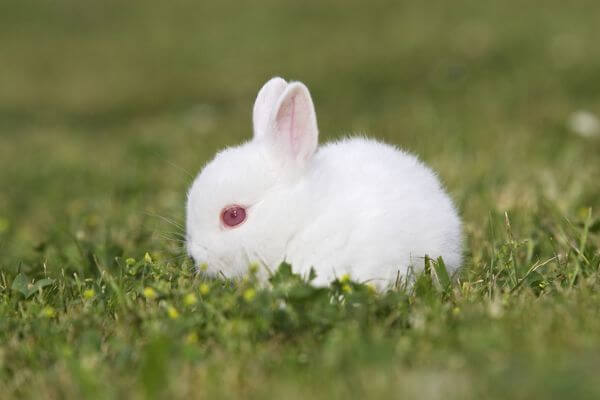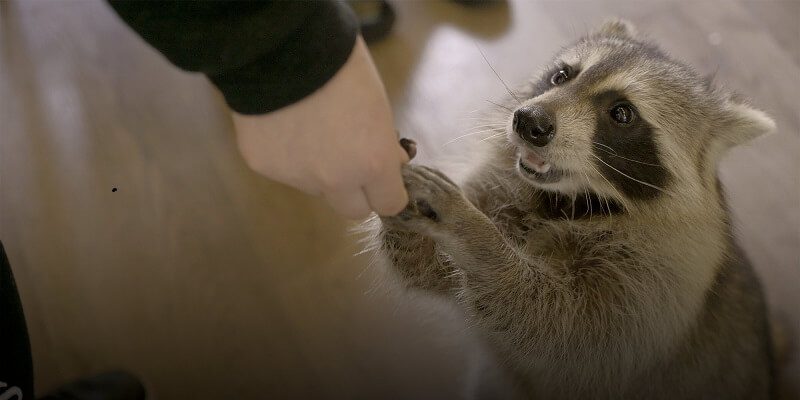The love for white led to the situation where people began to cross different animal breeds. This is how the albino hare, now widespread all over the world, has been bred. The breed was obtained in Germany by crossing a Belgian with chinchilla. As a result of a long selection among breeds, the former white giant was grown.
In nature, white rabbits are very rare. Their white as snow furs draw the attention of predators, especially in gray forests. To hide such staining color is almost impossible because bright white attracts attention from distance.
With its big ears and that nose that is constantly sniffing, the rabbit makes a nice pet. There are dozens of rabbit breeds to choose from, available in a variety of patterns and colors including black, gray, yellow. If you encounter a white rabbit with red eyes, you are looking at an albino rabbit.
Albino’s Genetic characteristics
Albino is an inherited feature, characterized by a lack of hair and skin color in an animal, and red or pink eye. An albino hare has a combination of mutant genes that has priority over all other combinations, resulting in a lack of tyrosine enzyme. Tyrosinase is responsible for controlling the production of melanin or pigment; no tyrosine means no pigment. In rabbits, it means white hair and red eyes.
The rabbit’s eyes
A rabbit that has tyrosine can have a variety of fur and eye colors. The pigments of eumelanin melanin, which are responsible for dark brown, and pheomelanin, which is responsible for brown, are present in the fur and rabbit’s eyes. If melanin particles in the eyes of a rabbit are small in diameter and very scattered, its eyes will be blue; if they are thicker and larger in diameter, its eyes will be brown. Red eyes in a white rabbit are not due to red pigments; remember, it has no pigment. Instead, his eyes appear red, because the iris reflects the light in his blood vessels instead of pigments.
When are red eyes in rabbits considered normal?
The holders of red eyes from birth can be white rabbits or albino rabbits. Albinism is not a disease. Albino specimens can be found within all the representatives of the animal world, most often mammals. And although people like white animals, that’s unnatural for them.
White is actually the absence of natural pigment. A certain gene is responsible for the production of pigment, which for some reason does not meet its duties. For the same reason, the albino lacks the color of their eyes. The iris of the albino animals is colorless, almost transparent. Blood vessels are visible through it. This is why white rabbits and other albino have red or pink eyes.
Scanning behavior
 Rabbits, which are predators evolved to have their eyes on both sides of the head to see 360 degrees. This is possible so they can always be in search of the approaching prey. Ironically, the rabbit has a blind spot directly in front of its nose.
Rabbits, which are predators evolved to have their eyes on both sides of the head to see 360 degrees. This is possible so they can always be in search of the approaching prey. Ironically, the rabbit has a blind spot directly in front of its nose.
Bunnies are far from having a great sight and don’t see too well until getting very close. They also tend to see in green and blue, because most of their food is green. Rabbits see things in two dimensions. They don’t easily tell the range and they practically have no sense of depth. They can see a cat, yet they can’t understand visually whether it’s 10 meters or fifty meters away. Their vision can identify a feline, but they tend to use other senses, such as smell and hearing, to find out how far it is.
Now, considering the absence of a full spectrum of colors and the inability to see things close, you should better understand a rabbit’s vision. This is why they tend to rely more on hearing and sense of smell to spot the danger around them. Their vision is essential, yet for close encounters, such as feeding, they use their nose more than their eyes.
The albino rabbit has fewer photographic receptors than an ordinary rabbit, so it can see in dim light very well. Its retina has fewer ganglion and amacrine cells that transmit information from the rods to its optical nerve. It has fewer optical fibers that lead to the same side of the brain, reaching a wrong part of its brain and finally mixing the inputs. This can explain what is called a ‘scan’ behavior in an albino hare. You may notice that your albino rabbit is looking at something by bending its head when it passes from eye to eye to discern what it is looking at. Don’t worry about scanning it; it’s a common behavior of the albino rabbit as it takes in its surroundings.
Red eyes in a rabbit due to injury or illness
There are a lot of white rabbit breeds among which there are The White Giant, The White from New Zealand, and others, that are characterized by red eyes. But if the rabbit is not white and the eyes are red or white, and they were initially of a different color, then turned red, this is a pretty big red flag. Red is often a symptom of eye or nose disease, allergies, or even injuries.
Conjunctivitis
The inflammation of the conjunctivae, of the mucosa of the eye, is called conjunctivitis. Rabbits often suffer from this disease; the first symptoms are redness of the eyepiece and eyelids, swelling of the eyelids, and itchy sensation. The causes of the inflammation can be multiple:
- foreign particles – dust, wool, small debris;
- damage caused by impact, perforation, or scratches;
- spray chemicals – fragrances, disinfecting and disinfecting agents, household chemicals;
- pathogenic microflora (viruses and bacteria);
- malnutrition – insufficient carotene (vitamin A);
- a complication of ear, nose, and mouth disease.
To minimize the risk of disease, you must remove the above factors
Allergic reaction
Rabbits, like humans, are prone to different types of allergies. Their eyes are very vulnerable and react to allergens more often than other organs. An allergic reaction is indicated by red eyes and also itching.
These symptoms are particularly common in domestic rabbits living in a human house. Here, they are surrounded by many chemicals, perfumes, cosmetics, various industrial foods – everything that can cause allergies.
Common causes of an allergic reaction:
- chemicals (household chemicals, flee medicines, perfumes, rabbit cosmetics such as shampoos and care products),
- necessary household items, e.g., bedding for an animal;
- smoke from a fire or cigarette;
- ammonia, which is abundant in rabbit urine, if its food is rich in protein;
- food (fruit, vegetables, compound feed).
If the animal’s ocular globes are reddish and irritated, it is urgent to determine the source of irritation and to remove it. Then, you should contact your veterinarian for advice.
Injury to tear ducts
Fairly often, redness may occur due to damage to tear ducts. The cause may be injuries of different origins:
- mechanical, such as shock;
- pathological (an abscess that develops near the eyes);
- congenital abnormalities (abnormal growth of the teeth roots).
If the tear duct is blocked by an increasing abscess or tooth, then you cannot fix it without the help of specialists. In such cases, surgery is necessary. Teeth reaching abnormal sizes are quite frequent. But its health problems cannot be minimized. Doing so may lead to serious eye damage, such as conjunctivitis, keratitis, and even loss of vision.
Nose damage caused by chronic disease
Red eyes can be a sign of infection if they are accompanied by a painful nose. The most common nasal infection is rhinitis, meaning the inflammation of the mucous membrane.
Rhinitis:
- weird and runny nose;
- swelling and reddish nose;
- discharge from nasal cavity;
- fever-like symptoms.
Rhinitis is a contagious disease spreading from a sick animal to a healthy one.
Prevention of rabbits’ eye diseases
Not all eye diseases are easy to cure, they often lead to complications, sometimes even death. Therefore, it is better to do everything to prevent them. Preventive measures include cage hygiene and regular checking at the veterinarian. Hygiene-wise, you should clean the cage daily; disinfect drinkers and feeders, every 10 days and before rounding, regularly clean rooms and clean equipment.
Not too bright, please!
Apart from light sensitivity, an albino rabbit has no special health problems to be aware of. It can be difficult for an albino in the wild because its white fur is an important give-out for potential predators. However, the safety of your home should be good. If he is confined to an area that has lots of bright light, be careful at his sensitive eyes and give him a shelter that gives him a certain shadow that will be easy for his eyes. Of course, those bright red eyes make an amazing contrast to his white coat, but there is nothing worse for an albino bunny; it is special.




